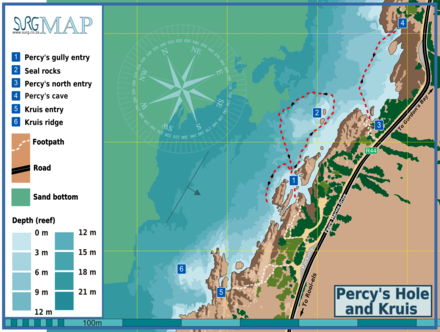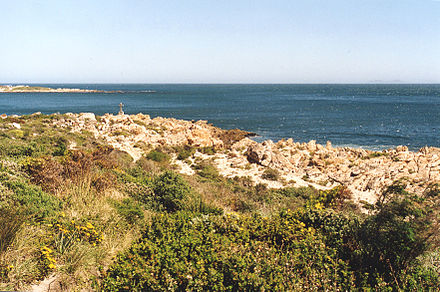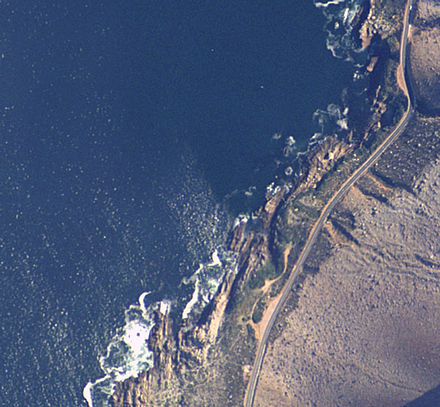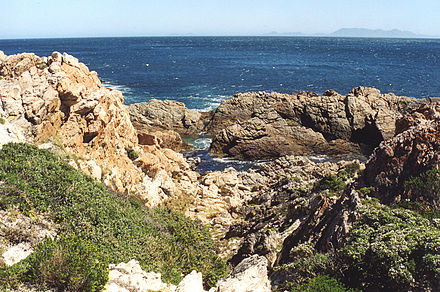Diving the Cape Peninsula and False Bay/Kruis - shoreline dive site near Rooi-els on the False Bay east coast
The dive site Kruis or Crosses is a shoreline rocky reef in the Rooi-els area on the east side of False Bay, near Cape Town in the Western Cape province of South Africa.
Understand

See also: Diving the Cape Peninsula and False Bay#Understand
Position
- S34°17.431’ E018° 49.304' Kruis (Entry and exit gully) 📍 18 km South of Gordon’s Bay, at the tip of a blunt headland to the north of the beach at Rooi-els
This site is NOT in a Marine Protected Area. A permit is not required.
Name

The site name "Kruis" or "Crosses" refers to the cross erected above the site in memory of J.F. Marais, Rector of the Stellenbosch Gymnasium (later Paul Roos Gymnasium), 25/10/1866 – 25/5/1901, who drowned in the vicinity.
Depth
Maximum depth is about 22 m on the sand.
Topography
 Sandstone ridges roughly parallel to the shoreline with occasional transverse gullies crossing the ridges, sometimes with pebble or sand bottoms. Underwater features are similar in character to those above sea level.
Sandstone ridges roughly parallel to the shoreline with occasional transverse gullies crossing the ridges, sometimes with pebble or sand bottoms. Underwater features are similar in character to those above sea level.
The entry gully opens into a small fairly shallow cove to the north east, towards Percy’s Hole gully. This inlet slopes down gradually to the north west over an extensive area of deeper low profile reef with some sand patches until it reaches the sand bottom at about 22 m depth about 200 m offshore. Around to seaward of the entry gully there is a fairly large, quite shallow ledge which extends 40 to 50 m to seaward before dropping steeply to the low deep reef. Further south there is a deep relatively bare gully where large numbers of enthusiasts dispose of ring nets in the lobster season. This has been named Ring-net Gully after the rusty ring nets caught up in the reef and red bait. The point to the south of this also falls off steeply to seaward, and there are a few moderate sized pinnacles in this area.
Geology: Ordovician Sandstones of the Table Mountain group, probably Peninsula formation (uniformly light grey, medium to coarse grained, well bedded quartzitic sandstone). Strike roughly north east, dip about 25° south east.
Conditions
The site is exposed to south west swell. Long period swells will result in poor visibility and a fairly rough entry and exit. The site is usually at its best during or after south easterly wind in summer, but there are also occasional opportunities in winter when there has been a spell of calm weather with no big storms in the South Atlantic.
This is an area which sometimes has cold water upwellings after the south east wind, and occasionally these upwellings bring clear cold water and excellent diving.
Keep a lookout for times when the swell forecast is short period and low, or is not from the south west.
Winter storms may bring in broken kelp to cover the bottom below the walls, and the visibility is likely to be poor due to suspended organic matter.
Facilities
Paved roadside parking at the site is usually adequate, but has been crowded on occasion.
Get in
See also: Diving the Cape Peninsula and False Bay#Boat dives
This site may be accessed by boat or shore entry.
Boats can either travel from Gordon's Bay or Harbour Island, both of which are about 18 km away, or from Rooi-els, much closer, but with a really small and poor slipway, and requiring a special launching permit only available to local residents.
Shore entry requires no complications, and is more popular, but it does require a bit of physical effort.
Getting there by road: Drive along the Faure Marine Drive (R44) from Gordon’s Bay toward Rooi-els. Parking is at the side of the road on large paved parking area at S34°17.404’ E018°49.389’.
Path to the entry area:
Walk toward the cross to the left, which gives this site its name. There is a rocky gap facing west which is reasonably accessible to a fit diver.
 Climb down to near sea level and over a ridge to a gully that opens roughly to the north shown in the middle of the photo.
Climb down to near sea level and over a ridge to a gully that opens roughly to the north shown in the middle of the photo.
 Entry and exit area:
Note the rock in the middle of the gully in the photograph. Entries can be made just to the right of the rock, or by jumping off the steep ridge to the right, where the gully is fairly deep.
Entry and exit area:
Note the rock in the middle of the gully in the photograph. Entries can be made just to the right of the rock, or by jumping off the steep ridge to the right, where the gully is fairly deep.
If this is not your style, you can climb down nearer to the water at the north end of this ridge. Exit is possible at the extreme south end of the gully if conditions permit, on the ledge in the right foreground. by getting past the rock into the relatively sheltered pool at the end. The ledge at the north end of the ridge is sometimes better. Otherwise make your own best choice. An alternative exit is at Percy’s Hole Gully to the north, which is usually more protected from south west swell.
 The entry and exit area at Kruis is in the foreground of this photo. Notice the surge past the rock in the gully. The gap on the far side is bigger and easier to negotiate than that on the near side. The tide was fairly low at the time that this photo was taken.
The entry and exit area at Kruis is in the foreground of this photo. Notice the surge past the rock in the gully. The gap on the far side is bigger and easier to negotiate than that on the near side. The tide was fairly low at the time that this photo was taken.
See
Marine life
See also: Diving the Cape Peninsula and False Bay#The marine ecology
Dense kelp forest inshore. Heavy red-bait in the exposed shallows, Galjoen over the high reef. The usual invertebrates for the area, though possibly not as varied as at Percy’s. The occasional seal may visit during your dive. <gallery mode=packed> Image:Cape Gurnard flashing its pectorals DSC08508.JPG|Cape Gurnard showing the blue on its pectoral fins Image:Galjoen over the shallow reef at Kruis DSC07579.JPG|Galjoen can sometimes be seen just below the white water </gallery>
Photography
Fairly good site for photography. Macro and other close-up equipment will give best results most often and the visibility is seldom good enough for scenic shots.
Routes
Swim out to the end of the gully, left over the ridge, and around the point. Keep the steep side of the reef to your left around to Ring-net Gully, then if time and gas allow, head out to sea from the end of the south side of Ring-net Gully. Then swing north east, and south back into the cove and exit from the inner end of the gulley if conditions permit.
Stay safe
See also: Diving the Cape Peninsula and False Bay#Stay safe
Hazards
No site specific hazards have been reported. Shore access requires a walk down a steep path and some scrambling over rocks. Exit can be tricky in larger swells due to strong surge in the gully. Swell can increase significantly over a short period, but this can be forecast quite reliably.
Skills
No special skills required.
Equipment
See also: Diving the Cape Peninsula and False Bay#Equipment
A light is useful for looking into crevices and to restore colour at depth, and a compass is useful for keeping track of where you are.
Nearby
- Blouklip 📍
- Blousteen Ridge 📍
- Whirlpool Cove 📍
- Percy’s Hole 📍
- Rooi-els Point 📍
- Coral Gardens 📍
- Andre se Gat 📍
- Balcony 📍
- Ankers 📍
- Mike's Point 📍
- Container Bay 📍
Back to the Alphabetical list of sites, or list of dive sites in the Rooi-els area
Other regional dive sites:
Kruis
Timezone:MultipleCoordinates:-34.29, 18.82